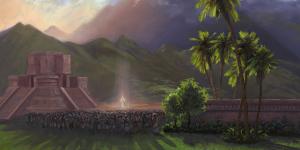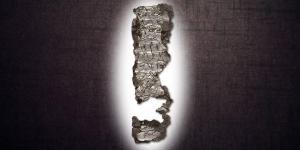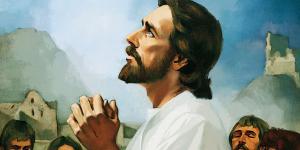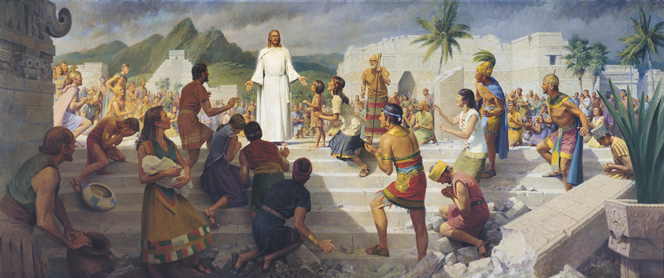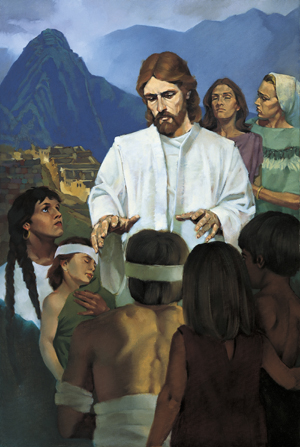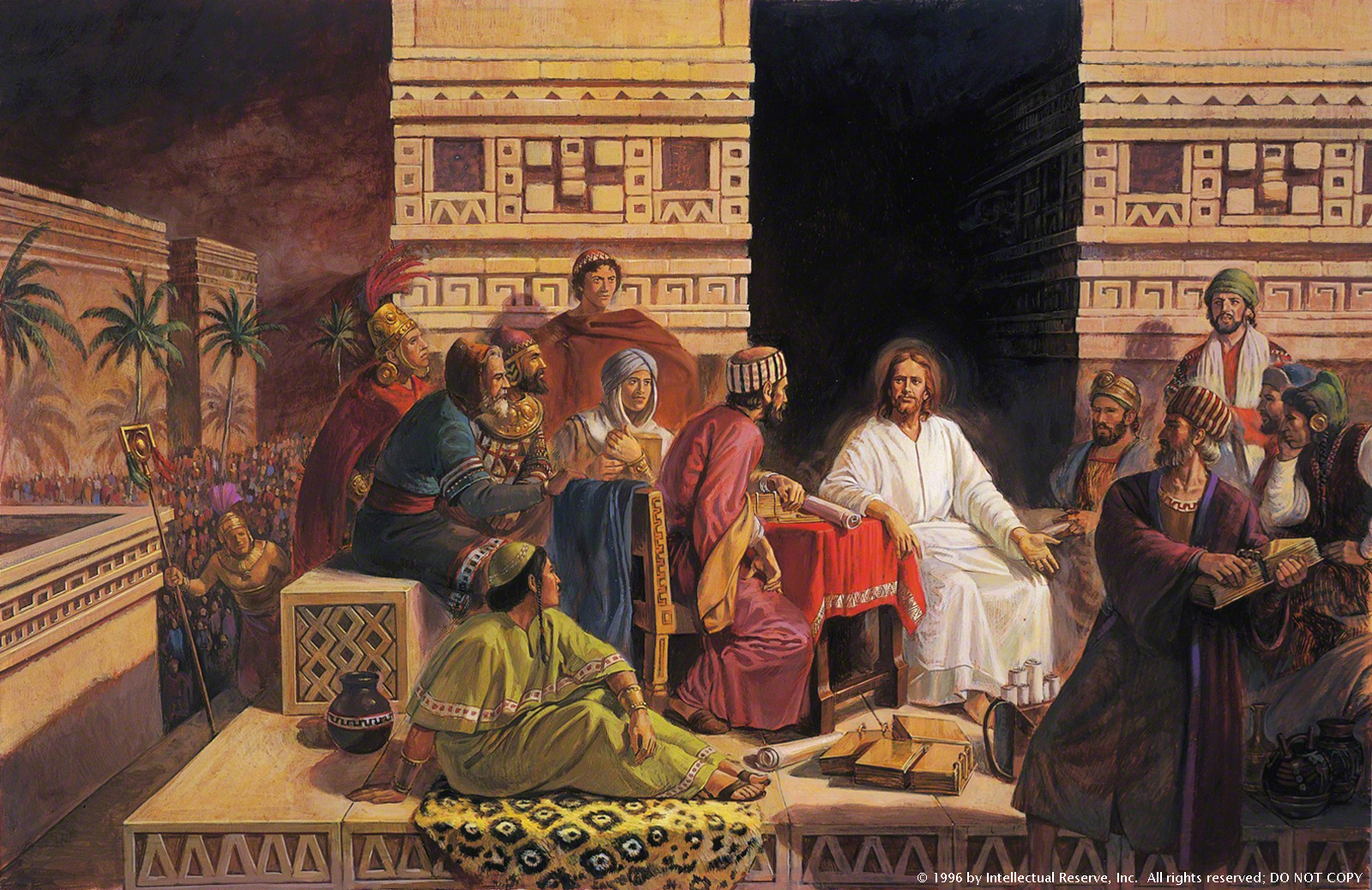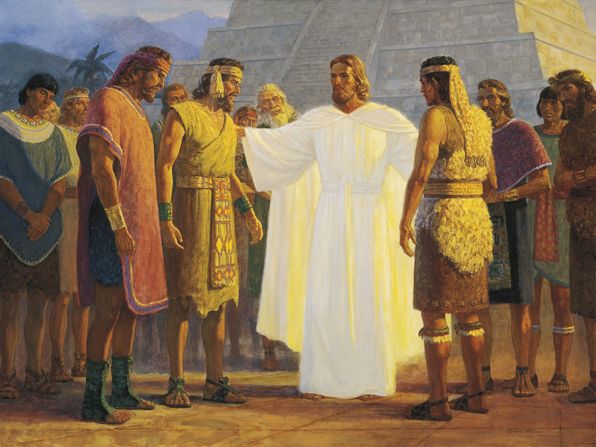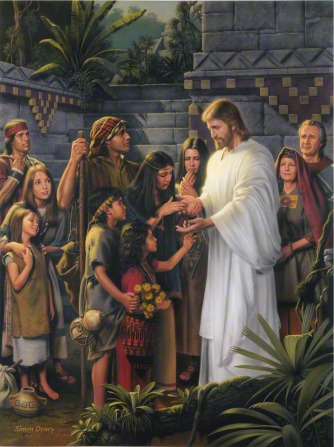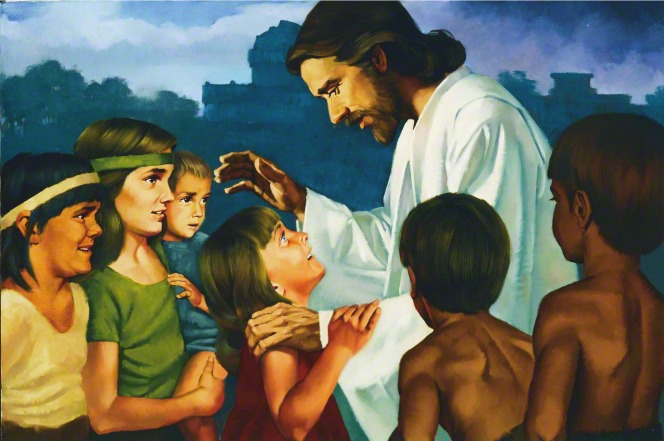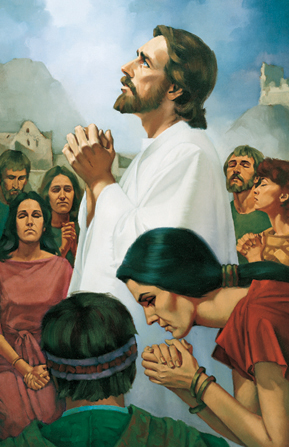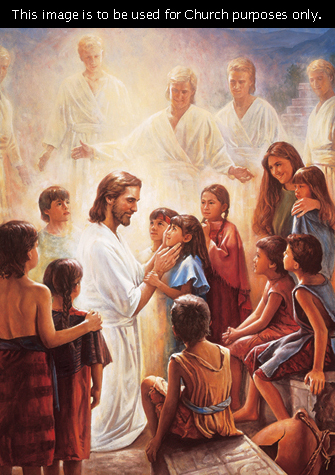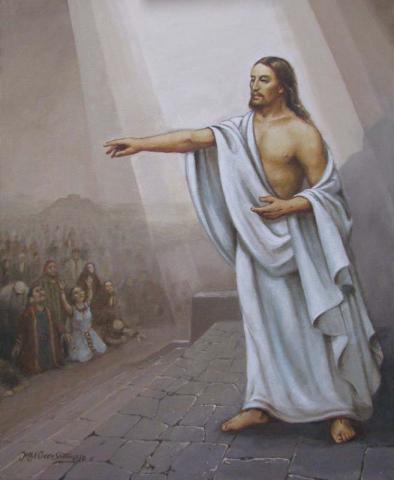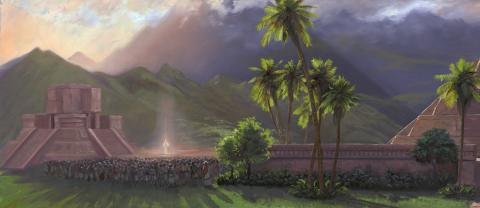You are here
Gospel Doctrine Lesson #39: Behold My Joy is Full

Scripture Block
3 Nephi 17-19
To help class members feel the love of the Lord Jesus Christ and develop a greater desire to exercise faith in Him and bear testimony of Him.
KnoWhys

Why Did Jesus Minister to the People One by One?
3 Nephi 17:21
Articles
Overview
Benson, Ezra Taft. "The Savior's Visit to America." General Conference Address April 1987.
A conference address from President Ezra Taft Benson on Christ's ministry among the Nephites in 3 Nephi.
Bokovoy, David E., and John A. Tvedtnes. "Christ in the Old Testament and the Book of Mormon." In Testaments: Links between the Book of Mormon and the Hebrew Bible, 7-23. Toelle, UT: Heritage Press, 2003.
All of the key events, doctrines, and people of the Hebrew Bible point directly to Jesus’ role as the Anointed One of Israel. This is the inspired message proclaimed so passionately by the ancient authors of the Book of Mormon: Jesus is the link between the Book of Mormon and the Hebrew Bible.
Holland, Jeffrey R.. Atonement of Jesus Christ In Encyclopedia of Mormonism, Edited by Daniel H. Ludlow. Vol. 1. New York: Macmillan, 1992.
An encyclopedic entry on the Atonement of Jesus Christ, as explained by Elder Jeffrey R. Holland. The Atonement is the core tenet of Christianity, and is the central focus of the Book of Mormon.
Ludlow, Victor L.. "Covenant Teachings in the Book of Mormon." In The Fulness of the Gospel: Foundational Teachings from the Book of Mormon, edited by Camille Fronk Olson, Brian M. Hauglid, Patty Smith and Thomas A. Wayment, 225-245. Provo, UT: Religious Studies Center, 2003.
This article discusses all the cases where Christ made covenants with his people in the Book of Mormon. Of note is the instance in 3 Nephi, when Christ visites the Nephites in the Americas and puts away the Law of Moses for a new covenant.
Matthews, Robert J.. "Jesus the Savior in 3 Nephi." In The Book of Mormon: 3 Nephi 9-30, This is My Gospel, edited by Monte S. Nyman and Charles D. Tate, Jr., 25-39. Provo, UT: Religious Studies Center, 1993.
This article discusses Jesus Christ's role in 3 Nephi. Third Nephi offers greater insight into the activity and scope of Jesus' work than that found in the New Testament alone. Matthew discusses the anticipation of Christ's coming, his miraculous appearance in the Americas, the doctrines he taught, and how Jesus Christ's coming is significant for the message of the Book of Mormon and the Gospel of Jesus Christ.
Millet, Robert L., Gary Lee Walker, Jerry C. Giles, Gerald Hansen, Jr., Andrew C. Skinner, Philip J. Schaelling, Daniel C. Peterson, Merril C. Oaks, Tad R. Callister, John Gee et al. Jesus Christ In Encyclopedia of Mormonism, Edited by Daniel H. Ludlow. Vol. 2. New York: Macmillan, 1992.
Encyclopedic entry on Jesus Christ, as he is understood in Mormon theology. Jesus Christ plays a central role in the Book of Mormon, especially when he appears to the Nephites in 3 Nephi.
Nelson, Russell M.. "Jesus the Christ - Our Master and More." In A Book of Mormon Treasury: Gospel Insights from General Authorities and Religious Educators, 19-31. Provo, UT: Religious Studies Center, 2003.
In a thoughtful overview, Elder Russell M. Nelson discusses how Jesus Christ fulfills each of Biblical and Book of Mormon titles attributed to him.
Seely, David R.. Jehovah, Jesus Christ In Encyclopedia of Mormonism, Edited by Daniel H. Ludlow. Vol. 2. New York: Macmillan, 1992.
An Encycopedic entry emphasizing the messianic role of Jesus Christ in Mormonism. Jesus Christ is the Jehovah and God of the Old Testament and was prophesied to come down to earth to redeem his people.
Tanner, N. Eldon. "Christ in America," Ensign. May 1975.
A Conference address from the First Counselor in the First Presidency on Christ in America. Starting with Biblical prophecies of Christ, President Tanner tells the story of Christ's appearance, expounding on the doctrines Christ layed out to the Nephites.
Turner, Rodney. "Christ's Church in America." Ensign. March 2000.
The Church of Jesus Christ experienced three phases in Book of Mormon times: the Old Testament-era Church among the early Nephites, the revitalization of the Church in Alma’s time, and the Church organized by the risen Lord.
Welch. John W. "Seeing Third Nephi as the Holy of Holies of the Book of Mormon." Journal of the Book of Mormon and Restoration Scripture 19, no. 1 (2010): 36-55.
Third Nephi and its account of the ministry of the resurrected Jesus to the Nephites has long been seen as the pinnacle of the Book of Mormon. This text can also be viewed as the Holy of Holies of the Book of Mormon. Everything in 3 Nephi, especially the ministry of the Savior, echoes themes related to the temple and the presence of the Lord in the Holy of Holies. Themes such as silence, timelessness, unity, awe, and consecration confirm this interpretation.
Hyde, Paul Nolan. A Comprehensive Commentary of the Book of 3 Nephi. Orem, UT: Parrish Press, 2015.
Kimball, Linda Hoffman. "The Coming of Christ." In The Reader's Book of Mormon: The Coming of Christ: Helaman 5 – 3 Nephi, edited by Robert A. Rees and Eugene England, vii-xxix. Salt Lake City: Signature Books, 2008.
3 Nephi 17
Halverson, Taylor, "3 Nephi 17-19: Christ's Visit to the Americas." Interpreter Resources for Students and Teachers October 9, 2016.
Bednar, David A. "One By One." Music from the New Era July 2016.
A new hymn with lyrics written by David A. Bednar on Christ's individual ministry to the Nephites in America.
Bowen, Matthew L. "'They Came Forth and Fell Down and Partook of the Fruit of the Tree': Proskynesis in 3 Nephi 11: 12–19 and 17: 9–10 and Its Significance." In Third Nephi: An Incomparable Scripture. eds. Andrew C. Skinner and Gaye Strathearn. Provo, UT: Deseret Book, Neal A. Maxwell Institute for Religious Scholarship, 2012.
Two times in 3 Nephi, the multitude fell down and worshipped Jesus. The act of bowing down and prostrating before an object of worship is known as proskynesis and is an example of Old World religion reflected in the New World of the Book of Mormon.
Holzapfel, Richard A. "One By One: The Fifth Gospel's Model of Service." In A Book of Mormon Treasury: Gospel Insights from General Authorities and Religious Educators. Provo, UT: Religious Studies Center, Brigham Young University, 2003.
This article expounds on the importance of individual ministry in our daily lives. 3 Nephi teaches the many ways that the Savior taught people on an individual and one-on-one basis.
Millet, Robert L. "The Praying Savior: Insights from the Gospel of 3 Nephi." In Third Nephi: An Incomparable Scripture. Eds. Andrew C. Skinner and Gaye Strathearn. Provo, UT: Deseret Book, Neal A. Maxwell Institute for Religious Scholarship, 2012.
In 3 Nephi, the Savior prays to the Father several times in an attempt to teach the Nephites. This example of prayer not only teaches us how we ought to pray, but it provides us many doctrinal and teaching tools in ministering to others.
Pace, Kevin G., and Mark R. Fotheringham. Forbid Them Not., 2015.
A piece of music which tells of the little children present when Christ came to America, and how Christ ministered unto them.
Parry, Donald W. “‘Pray Always’: Learning to Pray as Jesus Prayed.” In The Book of Mormon: 3 Nephi 9–30, This Is My Gospel. Provo, UT: Religious Studies Center, Brigham Young University, 1993, 137.
Parry discusses the purpose and process of prayer, drawing on the teaching of Jesus Christ among the Nephites in 3 Nephi 11-20.
Parry, Donald W. "'After This Manner...Pray Ye'" Ensign. January 1996.
In ten chapters of 3 Nephi, the Savior gives remarkable teachings on prayer that can shape our entire lives.
Rasband, Ronald A. "One by One." Ensign. November 2000.
A General Conference Address, talking about how we need to reach out to the one, just as Jesus Christ reached out to individuals in 3 Nephi.
Skousen, Royal. Analysis of Textual Variants of the Book of Mormon Part Five: Alma 56 – 3 Nephi 18 In The Critical Text of the Book of Mormon. Provo, UT: FARMS, 2014.
A reference work on the variants in the various editions of the Book of Mormon.
Sorenson, John L.. "Was There Leprosy Among the Nephites?" In Pressing Forward with the Book of Mormon: The FARMS Updates of the 1990s, edited by John W. Welch and Melvin J. Thorne, 231-233. Provo, UT: FARMS, 1999.
It may be confusing that Christ calls forth lepers to be healed, when it is generally thought that leprosy did not exist in ancient America. Sorenson proposes that what is rendered as "leprosy" may be referring to either uta or Chagas' disease.
Swift, Charles. "'So Great and Marvelous Things': The Literary Portrait of Jesus as Divine Lord in 3 Nephi." In Third Nephi: An Incomparable Scripture. eds. Andrew C. Skinner and Gaye Strathearn. Provo, UT: Deseret Book, Neal A. Maxwell Institute for Religious Scholarship, 2012.
While the Gospels in the New Testament sometimes emphasize Jesus's mortality, the Book of Mormon clearly paints Jesus Christ as the divine and glorified Son of God. 3 Nephi 17 talks about how "The eye hath never seen, neither hath the ear heard, before, so great and marvelous things as we saw and heard Jesus speak unto the Father."
Tvedtnes, John A.. "Becoming as Little Children." In The Most Correct Book: Insights from a Book of Mormon Scholar, 278-281. Salt Lake City: Cornerstone Publishing, 1999.
In 3 Nephi, the Lord places special emphasis on the humility and docility of little children. Christ exhorts all to become as little children, not only for their meek disposition, but because as we make sacred covenants, we become the children of Christ.
3 Nephi 18
Halverson, Taylor, "3 Nephi 17-19: Christ's Visit to the Americas." Interpreter Resources for Students and Teachers October 9, 2016.
Anderson, Kenneth W.. "The Twelve: A Light unto This People." In The Book of Mormon: 3 Nephi 9-30, This is My Gospel, edited by Monte S. Nyman and Charles D. Tate, Jr., 149-158. Provo, UT: Religious Studies Center, 1993.
From those present at his appearance in Bountiful, Christ chose twelve disciples, who were also apostles, to lead hisChurch as he had done in the Holy Land. These men would be responsible for proclaiming the gospelamong their people and for judging all of Israel.
Anderson, Richard Lloyd. "Religious Validity: The Sacrament Covenant in Third Nephi." In By Study and Also By Faith: Essays in Honor of Hugh W. Nibley. Vol. 2. Provo, UT: Deseret Book and FARMS, 1990.
This piece discusses the sacrament covenant laid out in 3 Nephi 18 by first discussing the importance of covenants in the Old Testament, the establishment of the sacrament in the New Testament, and the changing of the baptismal covenant in the Book of Mormon.
Bowen, Matthew L. "'In the Mount of the Lord it Shall Be Seen' and 'Provided': Theophany and Sacrifice as the Etiological Foundation of the Temple in Israelite and Latter-day Saint Tradition." Interpreter: A Journal of Mormon Scripture 5 (2013): 203-223.
While this article covers a variety of topics, Bowen discusses 3 Nephi 18:7, to talk about how Jesus Christ showing his body to the Nephites was a foundational theophany to their religion and to the ordinance of the sacrament.
Lambert, Neal E.. "The Symbolic Unity of Christ's Ministry in 3 Nephi." In The Book of Mormon: 3 Nephi 9-30, This is My Gospel, edited by Monte S. Nyman and Charles D. Tate, Jr., 195-209. Provo, UT: Religious Studies Center, 1993.
Lambert demonstrates how literary continuity is pervasive throughout the Book of Mormon, but especially in Christ's ministry in 3 Nephi. Specific themes are repeated often and follow a logical flow so that the narrative comprises a beautifully complex whole. The theme of little children is employed throughout 3 Nephi 17, while the motifs of light and healing are found throughout 3 Nephi 18.
McConkie, Joseph Fielding. "The Doctrine of a Covenant People." In The Book of Mormon: 3 Nephi 9-30, This is My Gospel, edited by Monte S. Nyman and Charles D. Tate, Jr., 159-181. Provo, UT: Religious Studies Center, 1993.
The idea of sacred covenant making with a chosen people is found throughout the Bible. This article shows that the covenants made in 3 Nephi fit perfectly with how it is taught in the Bible. This article highlights the covenant meal of the sacrament found in 3 Nephi 18.
Sweat, Anthony. "Active Learning and the Savior's Nephite Ministry." Religious Educator: Perspectives on the Restored Gospel 10, no. 3 (2009): 75-86.
As a result of increased expectations of Church youth, the standards of teaching for religious educators who instruct the youth have also risen. These higher teaching standards call for increased student participation in the learning process. The Lord's ministry among the Nephites presents an excellent case study of Jesus's teaching methods which serve as a model for teachers everywhere.
Welch, John W.. "Our Nephite Sacrament Prayers." In Reexploring the Book of Mormon, edited by John W. Welch, 286-289. Provo, UT: FARMS, 1992.
The sacrament prayers used today in the church can be found in the Doctrine and Covenants, but their predecesors are found in 3 Nephi 18. While there are slight differences in the prayers found in Mosiah 5, 3 Nephi 18, and Mormon 4-5, all testify of the atonement of Jesus Christ.
Welch, John W. "Reusages of the Words of Christ." Journal of Book of Mormon Studies 22, no. 1 (2013): 62-72.
This is an excerpt from and summary of an article by John W. Welch that appeared as “Echoes from the Sermon on the Mount,” in The Sermon on the Mount in Latter-day Scripture.
3 Nephi 19
Halverson, Taylor, "3 Nephi 17-19: Christ's Visit to the Americas." Interpreter Resources for Students and Teachers October 9, 2016.
Gee, John, John A. Tvedtnes, and Matthew Roper, "Book of Mormon Names Attested in Ancient Hebrew Inscriptions." Journal of Book of Mormon Studies 9, no. 1 (2000): 40-51, 78-79.
Mathoni and Mathonihah were the names of two of the twelve disciples chosen by Christ during his visit to the Nephites, and this article shows that these names can be attested in the Bible.
Hansen, Jr., Gerald. "Gathering to the Temple: Teachings of the Second Day." In The Book of Mormon: 3 Nephi 9-30, This is My Gospel, edited by Monte S. Nyman and Charles D. Tate, Jr., 211-223. Provo, UT: Religious Studies Center, 1993.
Jesus had the multitude go home to ponder, and then return the next day for instruction. The gathering on the second day, and the instruction given there, reflects patterns of gathering and temple learning found throughout the church. The article discusses gathering at the temple, gathering in the premortal existence, gathering of the house of Israel, and how gathering is part of God's plan.
Nyman, Monte S.. "The Designations Jesus Gives Himself in 3 Nephi." In The Book of Mormon: 3 Nephi 9-30, This is My Gospel, edited by Monte S. Nyman and Charles D. Tate, Jr., 41-58. Provo, UT: Religious Studies Center, 1993.
After the destruction in 3 Nephi, the voice of Christ is heard. Christ cries repentance to his people and declares who he is, using various names and titles. This article discusses the significance of each of those names.
Ricks, Stephen D. "I Have a Question." Ensign October 1992.
The name of one of the Lord’s disciples listed in 3 Nephi 19:4—Timothy—seems to be Greek in origin. It may be that the name Timothy, as well as other manifestations of Greek influence, was brought to the New World by the Mulekites.
Skousen, Royal. Analysis of Textual Variants of the Book of Mormon Part Six: 3 Nephi 19 – Moroni 10 In The Critical Text of the Book of Mormon. Provo, UT: FARMS, 2014.
A reference work on the variants in the various editions of the Book of Mormon.
Spackman, Beth T. "I Have a Question." Ensign. June 1988.
In 3 Nephi 19:16–30, we read that, when Jesus was in their immediate presence, his disciples prayed directly to him. Apparently, on that occasion, while he was in their presence, praying to him was acceptable. After he left them, however, the Nephites continued the pattern of praying to the Father in Jesus’ name, as we are directed to do also.
Welch, John W. "The Lord's Prayers." Ensign. January 1976.
Welch emphasizes the importance of learning from the prayers of Jesus Christ found in scripture. There are few instances, but each one fills our lives with richer meaning. As part of this discussion, Welch draws on the Lord's Prayer and Christ's prayer on behalf of the Nephites in 3 Nephi.
Welch, John W. "Reusages of the Words of Christ." Journal of Book of Mormon Studies 22, no. 1 (2013): 62-72.
This is an excerpt from and summary of an article by John W. Welch that appeared as “Echoes from the Sermon on the Mount,” in The Sermon on the Mount in Latter-day Scripture.
"Timothy." Book of Mormon Onomasticon
Etymology of the Greek name "Timothy" as found in 3 Nephi 19:4

